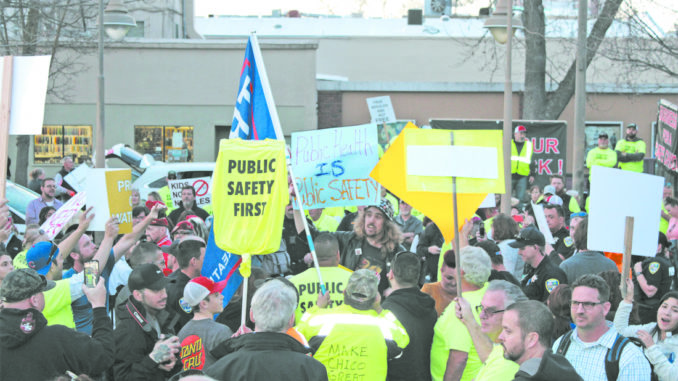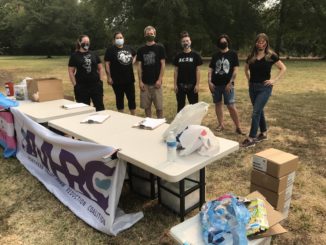
Tensions over syringe access in Chico, a polarizing issue since the Northern Valley Harm Reduction Coalition began distributing and collecting needles in October, have boiled over this spring. As reported in the CN&R, an alliance of business and residents filed a lawsuit last month challenging NVHRC’s program, and protests this month have grown increasingly contentious—even violent.
The city of Chico does not sanction syringe access; NVHRC is authorized by the California Department of Public Health. But the events each Sunday at Humboldt Park have not escaped the attention of city leaders. Councilman Randall Stone requested that the council, at its special meeting Tuesday (May 26), consider agendizing “a discussion of escalation of attacks during NVHRC events.”
His request came on the heels of the state health department expanding the scope of NVHRC’s operations to include deliveries, in part as a response to the protests.
A letter from the state dated May 22 affirming this change—effective through Oct. 14, 2021—says delivery service “supports the statewide objective of promoting social distancing during the coronavirus pandemic, and … may reduce the public visibility of the program, reduce community tensions, and better protect participants and volunteers.”
Stone posted the document on Facebook. Both at the council meeting and in a phone interview with the CN&R, he said he’d requested information from city staff about the situation but got none in reply, spurring his request for a council discussion.
“Strangely enough, despite being beleaguered by COVID-19 concerns, the state took action to mitigate that [NVHRC] concern before I got an update from city staff about what we may be doing in that regard,” Stone told the CN&R. He made the same point at the council meeting.
Council menbers voted unanimously to hear a report from City Manager Mark Orme, who said that the city “didn’t permit the use”—meaning, issue the authorization—“so to manage the use would overstep a boundary.”
Orme called upon Deputy Police Chief Matt Madden for more specifics. Madden—named interim chief the next day (May 27) as the city seeks a replacement for retiring Chief Mike O’Brien—did not have incident reports on hand but said the department has engaged groups involved to educate them about city regulations regarding public spaces.
Saying Chico PD has “a plan moving forward” for NVHRC events, he added: “Our job is to keep the peace. We’re going to stay fair and impartial and enforce the law.”
Unwelcome presence
That police officers have come to Humboldt Park represents the crux of the matter. The need for law enforcement elevated syringe access events to a council matter.
Angel Gomez, program manager for NVHRC, says police presence dissuades people from seeking services and, coupled with pressure from protesters, prompts many to bypass support services.
For Nichole Nava—who, through her Facebook group One Chico, organized an adjacent event at Humboldt Park last Sunday (May 24)—the disruptiveness that’s drawn the police detracts from what she and others hope to accomplish. Nava opposes the syringe access program but also provides referral resources.
Contacting city administrative staff May 18, Stone said, was the result of his becoming “increasingly frustrated in the lack of attention being paid” to the protests. He sought information from O’Brien and Orme, whom he emailed.
“If this were happening if front of Councilmember [Kasey] Reynolds’ business, how would we be responding?” he continued. “If this happened in front of my business, how would I expect the city to respond? And if this were happening in front of Stonewall [Alliance Center of Chico], or at an activity that Stonewall was having at a remote location routinely … given the escalation, what would the city be doing?”
Orme told the CN&R by email that City Clerk Debbie Presson had forwarded Stone’s request to City Attorney Andrew Jared, as Stone raised the prospect of confidentiality should Chico PD be investigating the aforementioned incidents. With Presson telling Stone that “the City Attorney could figure out the best path forward,” Orme continued, “It was left there. Staff was surprised by the accusation.”
As for municipal action, Orme said the city could issue NVHRC a permit to operate in the park. Because Humboldt Park “is not a specified reservable area,” that would require a Park Reservation Permit, which takes approval of the Bidwell Park and Playground Commission, subject to City Council appeal.
Since NVHRC receives its sanction from the state, Gomez went to the state Public Health Department to seek relief. She formally requested the allowance for delivery service on April 24.
Gomez’s group offers access to clean syringes and disposal of used ones, along with counseling for social services, testing for HIV and hepatitis C, and training in the use of nalaxone, a medication that reverses effects of an opioid overdose. California’s Public Health Department authorized the program in October 2019.
After a few weeks of protests in which the opposition grew louder, plus filmed and confronted service-seekers, she said NVHRC “anticipated that [animosity] could escalate…. We wanted to find a way to still be able to give people full services without having to deal with that stigma, because that’s kind of the opposite of what we’re trying to do.”
Police responded to an altercation May 17 between a protester and a recipient of services. Last Sunday, police came again after two women made physical contact and exchanged words.
Gomez has no issue with the conduct of Chico police officers, just with the impact of their arrival on scene.
“Every time they’ve been out there, they’ve been respectful,” she told the CN&R by phone. “They’re not concerned with who’s accessing services or with interrupting that process. But their mere presence is a deterrent for many people, and it really shouldn’t be necessary to have their presence there.”
Nava agrees, in that she reinforced a “peaceful, respectful, civil” approach for participants at her event last Sunday. At Humboldt Park, where NVHRC set up its tent, Nava’s group gathered to offer snacks and resources to people addicted to injection drugs. Those volunteers included a nurse and others with backgrounds in social services.
“We’ve been out there a couple times before—we had gals who had the [resource information] sheets—but not to the scale we did this time,” Nava said by phone. “So I wanted to take it up a huge level because it was impactful; we could see we had reached some of the addicts with what we had, so we wanted to make sure to expand some of the referrals and make sure to be inclusive with rape crisis, domestic abuse.
“There are other things that go along with being an addict and unhoused that need to be addressed, so we wanted to be more holistic about it. And, honestly, I guess we were surprised: We did think that there was more of a referral and a connection was happening at the NVHRC, and when we determined that wasn’t happening, a few months ago, we really had to amp up our game with trying to draw attention to that and fill that gap.”
Gomez said NVHRC refers people to services, determining what they need during an intake that involves confidential conversation. Opponents, even well-intentioned, have affected this process.
“Their presence and tactics actually have interfered and significantly reduced our ability to do referrals,” Gomez said. “Ever since the protesters have shown up, nobody wants to stick around to talk about services; they want to get in and out as quickly as possible.”
Heading out
Gomez did not watch Tuesday’s council meeting live, as she had another meeting that night. NVHRC has had a busy week preparing to launch delivery service. Once the group coordinates schedules of clients and volunteers, she said, deliveries can begin.
The state allows NVHRC to deliver syringes and retrieve “sharps” containers from homes. That definition includes “tents, recreational vehicles and other non-traditional forms of housing.” As such, the group also may serve clients living in cars. Volunteers will provide the full range of services offered at events, notably referrals.
Those seeking delivery need to consult a group volunteer to establish eligibility. Criteria include needs for privacy and sheltering-in-place; problems with transportation; and scheduling conflicts with NVHRC’s events Sunday mornings.
Gomez said the group anticipated approval for the delivery service. NVHRC didn’t really want to apply for it, she added, “but a person can only be yelled at and followed and put on video so many times before they reach a breaking point, so we wanted to try to prevent that.”
Nava also wishes the approval wouldn’t have happened. Already opposed to NVHRC, Nava finds multiple red flags in delivery.
“Drugs break families down—there is nothing good about drugs being in a home,” she said, adding: “I hope I’m surprised and they offer [referral] services every time they do a visit. I also hope this gets kiboshed quickly, because I think it’s horrible.”
The council did not discuss this development, but Vice Mayor Alex Brown raised the possibility of NVHRC moving. Discussion at the Butte County Board of Supervisors meeting that day centered on finding a building for NVHRC, or perhaps letting the group operate out of a county Public Health parking lot. Madden said Chico PD made that recommendation in talking with Public Health and NVHRC.


